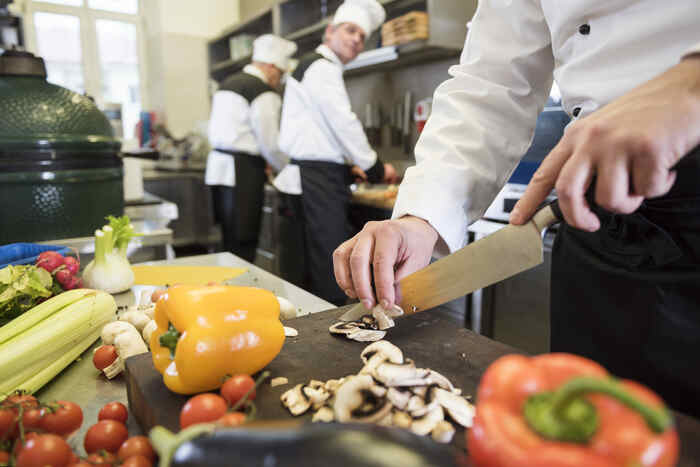
And as a restaurant employee, it is important to take food safety seriously and to be prepared to handle cases of food poisoning. Here are some steps you can take to handle food poisoning in a restaurant:
Identify the Symptoms
The first step in handling food poisoning is to identify the symptoms. Employers should offer training to their employees on food poising to help them know the symptoms they should look for in case of food poisoning. The common symptoms of food poisoning include nausea, vomiting, diarrhea, stomach cramps, and fever. If a customer complains of any of these symptoms, take it seriously and investigate further.
Isolate the Food
The first thing to do if you suspect a particular dish may cause food poisoning is to isolate it immediately. This will reduce the risk of poisoning other customers as it will prevent them from consuming contaminated food.
Notify Management
As an employee, if you suspect food poisoning, you should notify the management immediately. This will give them time to assess the situation and take action to prevent further contamination or address any legal issues that may arise.
Offer Assistance
Offer assistance to the affected customer. When offering assistance, you should adhere to the first aid guideline for handling food poisoning. You can offer assistance by providing water, directing them to a restroom, or calling for medical help if necessary.
Follow Proper Procedures
Make sure to follow your restaurant’s procedures for handling food poisoning. This may include filling out incident reports, contacting local health authorities, and properly disposing of contaminated food.
If you have basic first aid knowledge, strictly follow the guidelines. Here are some first-aid tips that can help manage food poisoning:
- Rehydration: Encourage the affected person to drink plenty of fluids to prevent dehydration. Water, clear broth, and sports drinks can be helpful. Avoid caffeine, alcohol, and sugary drinks, which can worsen dehydration.
- Rest: Encourage the affected person to rest and avoid strenuous activities that can worsen their symptoms.
- Medications: Over-the-counter medications such as antidiarrheal drugs and antacids can help manage some of the symptoms of food poisoning. However, consulting with a doctor or pharmacist before taking any medication is essential.
- Cool Compress: Applying a cool compress or a damp cloth on the forehead or the back of the neck can help relieve fever and other symptoms.
- Seek Medical Attention: If the symptoms are severe or persist for more than a few days, seek medical attention immediately. Severe cases of food poisoning can lead to dehydration, organ damage, and other complications.
It is important to note that first aid measures are not a substitute for proper medical care. If you suspect someone is experiencing food poisoning, encourage them to seek free medical consultation and attention as soon as possible.
Communicate with Customers
Communicate with customers about the situation and any steps you are taking to address it. Be honest and transparent about what happened and what you are doing to prevent future incidents.
Prevent Future Incidents
Preventing food poisoning incidents in a restaurant requires a proactive approach to food safety. Here are some steps you can take to prevent future incidents:
- Train your staff: Ensure that all staff members receive proper training in food safety, including hand hygiene, cross-contamination prevention, and temperature control.
- Monitor food quality: Regularly check food quality, including the smell, appearance, and texture of food items, to identify any signs of spoilage or contamination.
- Practice proper storage: Store food items at the correct temperature and location to prevent cross-contamination and spoilage.
- Implement a food safety plan: Develop a food safety plan that includes standard operating procedures for handling and preparing food, regular cleaning and sanitizing schedules, and protocols for responding to food safety incidents.
- Conduct regular inspections: Regularly inspect your kitchen and equipment to identify and address any potential sources of contamination.
- Communicate with suppliers: Communicate with your suppliers to ensure they follow proper food safety procedures and provide high-quality ingredients.
- Monitor food recalls: Stay informed and remove any affected products from your inventory immediately.
- Respond promptly to incidents: If a food poisoning incident does occur, respond promptly by removing any contaminated food items, sanitizing your kitchen and equipment, and reviewing your food safety procedures to prevent future incidents.
By implementing these food safety measures, you can reduce the risk of food poisoning incidents in your restaurant and ensure that your customers enjoy safe and high-quality food.
Conclusion
Handling food poisoning in a restaurant requires a combination of prevention, preparation, and prompt response. You can reduce the risk of food poisoning incidents in your restaurant by implementing proper food safety measures, such as staff training, monitoring food quality and storage, and developing a food safety plan.
